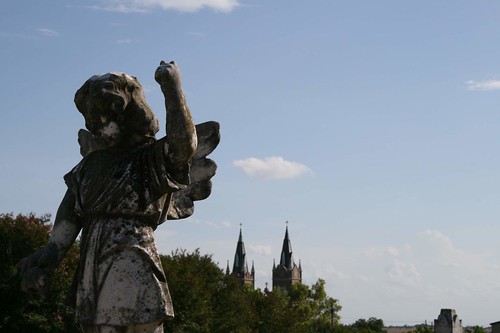One day Mr. Oddbooks came home and told me about a cemetery near Jarrell, Texas that was evidently very interesting. It was located in a ghost town called Corn Hill. Old Corn Hill Cemetery boasts the graves of people of historical importance in Texas, so I wanted to check it out. Cemetery, ghost town, historical importance – what’s not to like? The problem was that the directions were so bad that I really think that had we closed our eyes and tried to get there by our sense of smell, we wouldn’t have ended up as lost as we became.
It took us a couple of weekends to find Old Corn Hill Cemetery, but during the hunt we found a couple of very interesting mini-cemeteries, a derelict house where we totally trespassed and took pictures (I later learned that house is the James Shaver home, called the Old Stage Stop and Hotel), and all sorts of interesting fauna, mostly longhorn cattle. But we also found the Holy Trinity Catholic Cemetery, which has become the cemetery to beat for me in terms of symbology, statuary and emotional attachment.
Holy Trinity Catholic Church in Jarrell, Texas, is an imposing building, very gothic without any accompanying morbidity, which seems strange to say given that the cemetery is essentially in the church’s backyard. Corn Hill, Texas was established in 1848 and began to die a slow death in 1910 when railroad lines bypassed Corn Hill in favor of neighboring Jarrell. The Holy Trinity Catholic Church was built in 1914, and, as I’ve mentioned before, in such a young state as Texas a hundred year old church has serious history behind it. Corn Hill itself was not founded by Germans and Slavs, but their influence is felt heavily in this area. People who aren’t familiar with Central Texas and the Hill Country are often surprised to know that huge swaths of this area are to this day very German and Slavic, especially Czech Moravian. For decades many Moravian families spoke a Moravian Czech dialect, as well as English, being bi-lingual in the way that we tend to associate with Mexican and Central American settlers to this area. Sadly, this dialect with pidgin elements is dying off though you still see lots of signs and bumper stickers boasting the phrase, “Jak se mas?” which translates as “How are you doing?” In short, Czech for “Howdy!”
Holy Trinity Catholic Church is heavily Czech and the cemetery reflects it. I loved this cemetery not just because it was exotic to my austere Southern Baptist upbringing, but also because it was, quite literally, an education investigating the stones. Eventually my friend Barbora K., a resident in Slovakia, had to help me translate much of what is written on the stones. This cemetery was the gateway to me learning about the German, Moravian and Bohemian influences in Central Texas. It also taught me a lot about how cemeteries are arranged in Eastern Europe. Others feel strongly about this cemetery as well – I get at least one message a month from someone who finds my photos and wants to share their experiences with the church or ask if they can use some of my pictures.
And I know this isn’t particularly spooky or Halloween-y, but cemeteries in the bright Texas sun simply cannot be creepy unless you’re out in the middle of nowhere near dusk. But there is still a somber, gloomy mood to this cemetery, especially when you get to the “babyland” section. The cemetery is a strange mix of dereliction and utter devotion because while many graves and statues have not held up in the Texas heat, every grave has been tended to by church members, even the ones where the stone is missing and all that is left are little metal markers so weathered the names were unreadable. The cemetery is grim yet comforting.

I am not a particularly good photographer but this angry angel is one of my favorite pictures I’ve taken. You can see the church spires peeking behind the trees.